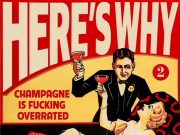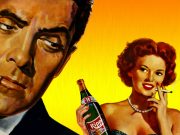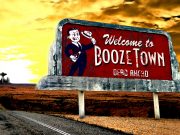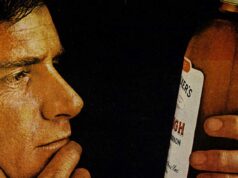
Smirnoff is the best-selling vodka in the world.
It was the brand that launched the vodka industry in Europe and, most especially, in America. For a good part of the 20th century, Smirnoff was the only vodka readily available in the States. The bottles being poured in US bars and liquor cabinets, however, were about as Russian as Mickey Mouse.
The brand was started by Ivan Smirnov during the Napoleonic Wars. The distillery remained rather modest in scale until his grandsons, Nicholai and Vladimir, took over the operation just before Ivan’s demise in 1893. Under their guidance business exploded. Unfortunately, Nicholai and Vladimir ran afoul of Lenin and his Bolshevik toadies (sounds like a rock band), the former being executed and the latter dying in poverty. According to legend, however, just before his death, Vladimir passed the secret Smirnov recipe to an expatriate Russian businessmen named Rudolph Kunett. (Author A.J. Baime has hypothesized that the “secret recipe” surely read something like: “Make flavorless alcohol for the masses as fast as possible and out of anything at all.”)
Mr. Kunett was a successful NYC salesman who had escaped to America during the Communist Revolution. After allegedly acquiring the secret recipe from Vladimir in Paris, Kunett decided his adopted nation was ripe for a revolution of its own, this one centered around vodka. He quit his sales job and moved to Bethel, CT, where, in 1933, he opened a small distillery and launched the “new” Smirnoff brand.
Which almost immediately sank into a morass of massive debt. Americans, he discovered, didn’t give two flasks about vodka, and cared even less about any “secret” Russki recipe, which Kunett tried without success to sell for $50,000 in 1939. Later that same year, however, Kunett made the acquaintance of the man who would turn everything around, a Cambridge-educated Yank named John Gilbert Martin.
Mr. Martin owned a company called G.E. Heublein & Brothers in Hartford, Connecticut, which specialized in the import/export of liquors and unusual foreign foods. The company had itself been saved from bankruptcy in 1938 when their most unlikely product suddenly found a market on the East Coast. It was a spicy condiment called A-1 Steak Sauce. Against the wishes of his family and advisors, Martin used the $14,000 he made off A-1 to buy the Smirnoff operation in late 1939, right on the eve of America’s entrance into World War II.
The first bottles of Smirnoff that staggered off the assembly line were labeled “Smirnoff’s White Whiskey—No Smell! No Taste!” and the marketing folks at G.E. Heublein must be credited with a brain wave for deciding to concentrate their sales machine in the South, specifically North Carolina, where it quickly found an audience among moonshine enthusiasts (straight from the still, vodka and moonshine share a number of similarities). Grain rationing to aid the American war effort caused a downturn in Smirnoff sales and the company was left without Martin’s leadership savvy for several years after he joined the Army. He served in France and North Africa before being discharged in 1944 as a lieutenant colonel, after which he returned to Connecticut and devoted himself to taking Smirnoff national.
Martin’s first stop was southern California. In 1946 he popped by a Hollywood tavern called the Cock ‘n’ Bull, owned by Jack Morgan, an old pal of Rudolph Kunett. Mr. Morgan was somehow in possession of a ton of ginger beer but all his efforts to sell the stuff in his bar had proved fruitless. He had never heard of Smirnoff vodka, but was willing to listen to Martin wax rhapsodic about it, and the two men donned their drinking hats and started experimenting with new cocktails that incorporated Morgan’s ginger beer and Martin’s vodka. After some trial and error, they came up with the legendary Moscow Mule (1 shot of vodka and a splash of lime juice over ice in a copper cup filled to the top with ginger beer.)
With the advent of the Moscow Mule, sales of Smirnoff started to rise. And in 1949-50 they exploded, as the country settled into what would come to be called the Cocktail Age. As Americans of all stripes and incomes embraced the cocktail, vodka became a mainstay of household liquor cabinets and bars went through hundreds and thousands of cases, selling vodka as fast as distributors could deliver it.
Sales were so fantastically robust, the “vodka craze” eventually came to the attention of J. Edgar Hoover. The FBI Chief joined forces with the equally Red-obsessed Joseph McCarthy, and the two men aimed their paranoia at vodka, which by their keen logic, could only be popular because of Soviet influence. In 1954, they exhorted patriotic New York City bartenders to march in protest against the Commie potion. And march they did. A few of them, anyhow. They marched through the city chanting against the Reds and carrying banners reading, “Down With the Moscow Mule—We Don’t Need Smirnoff Vodka!”
Asked later what he thought of the protests, Martin responded: “It was great! All the people who saw the sign were rushing into the bars to buy the drink.” He wasn’t exaggerating – Smirnoff sales tripled during the weeks following the protest.
Smirnoff continued its dominance of the vodka industry for decades, all the way up to the onslaught of new brands—notably Absolut—which flooded the market in the 1980s. These days, Smirnoff is considered a “well” alcohol, having been pushed down a notch on the scale by new top-shelf brands (Chopin, Gray Goose, etc.) and their claims of better flavor and a cleaner product. Personally, I find it perfectly palatable, a splendid vodka for any mixed drink. I might go to a slightly pricier label if dry vodka martinis are on the menu, but for most cocktails there is no point (aside from elitism, of course) in spending a dollar more than is necessary.










